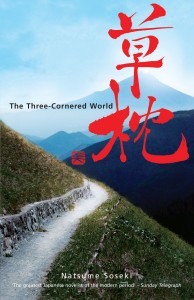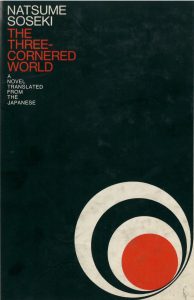Authors > Damian Flanagan introduces Soseki’s Three-Cornered World
 . . . a classic translation of one of the most famous works of Japanese literature, a tour de force by the writer universally recognized in Japan today as that country’s greatest modern writer, if indeed not the greatest of all time. It is not his most famous work – I Am a Cat, Botchan and Kokoro vie for that crown – but given that at least a dozen of the works of Natsume Soseki (1867–1916) qualify as stand-out masterpieces in their own right, it is perhaps as fatuous to ponder whether this book is his ultimate masterpiece as it is to ponder whether Hamlet is a greater play than Othello.
. . . a classic translation of one of the most famous works of Japanese literature, a tour de force by the writer universally recognized in Japan today as that country’s greatest modern writer, if indeed not the greatest of all time. It is not his most famous work – I Am a Cat, Botchan and Kokoro vie for that crown – but given that at least a dozen of the works of Natsume Soseki (1867–1916) qualify as stand-out masterpieces in their own right, it is perhaps as fatuous to ponder whether this book is his ultimate masterpiece as it is to ponder whether Hamlet is a greater play than Othello.In the West The Three-Cornered World has, since its publication in 1965, enjoyed something of a mini-vogue, although – generally omitted from academic literature courses – the book has almost invariably been read out of context with no reference to Soseki’s other works. And yet the novel has consistently thrilled those readers who have discovered it.
Very rarely for a translated work of a Japanese classic, the translation itself has both a distinct personality and has affected readers in ways strikingly different from the original book in Japan. Indeed, although by no means ever attaining mainstream status, the success of this particular translation was such that it made The Three-Cornered World perhaps the most appreciated of all Soseki’s works in the West. Furthermore, the translation had a transformative influence on one of the greatest musical geniuses of the twentieth century . . .
In 1967 the world’s most famous pianist, Glenn Gould (1932–82), was travelling back on a train from a vacation in Antigonish in Nova Scotia. Gould had shot to fame at the age of twenty-two for his revolutionary interpretation of Bach’s Goldberg Variations and for the next nine years had dazzled concert halls around the world with a maverick style of piano playing. The greats of the classical-music world, such as Leonard Bernstein, readily hailed him as a genius.

“I suppose you could say that an artist is a person who lives in the triangle which remains after the angle which we call common sense has been removed from this four-cornered world.” – Natsume Soseki, The Three-Cornered World
Gould was a complete original not only in his actions but in his thoughts. He derided Chopin and many of Mozart’s works, claiming to be amazed that Mozart garnered such respect from critics when the Austrian was just a gaudy, look-at-me child who always sacrificed substance for ready applause. Gould was entirely comfortable in disregarding the establishment and pursuing his own path. He saw himself not only as a musician but as an all-round creative artist, as interested in writing and performing the written word as he was in playing music. He created a plethora of imaginary characters to satirize the pomposity and pretension of the world of classical music and turned his attention to radio broadcasts on subjects that took his interest.
In 1967 Gould was sitting alone in the club car of the train when he was recognized by a professor of chemistry at St Francis Xavier University called William Foley, who summoned up the courage to express his admiration of Gould’s musical recordings and engaged him in conversation. The two men struck up a rapport, and during this conversation Foley mentioned a fascinating book he had recently read called The Three-Cornered World. When the two men parted Gould presented a record of his rendition of Beethoven’s Emperor piano concerto to Foley, and later Foley returned the favour by sending a copy of the Peter Owen edition of The Three–Cornered World to Gould.
Rarely can a book so randomly encountered have had such an impact on its reader. The Three-Cornered World was a work that was not just to become Gould’s favourite book but one that obsessed him for the last fifteen years of his life. Despite having no particular interest in Japan or having ever visited that country he ended up owning four copies of the book, two in English and, amazingly, two in the original Japanese. He seems to have bought every translation of Soseki’s novels that existed and had more books by Soseki in his library than by any other writer. To his cousin, Jessie Grieg, the person closest to him throughout his life, he expressed his love of The Three-Cornered World by reading it out over the telephone in its entirety over the course of two evenings.
Not only was the copy he received from Foley heavily annotated (sadly this and other materials were lost in transit at the time of a Gould exhibition in Paris in 1988) but Gould actually produced thirty-seven pages of separate notes on the novel. He condensed the first chapter and read it out as a fifteen-minute radio broadcast for the CBC radio show Book Time in December 1981 (the same month as he reinterpreted and rerecorded, after a gap of twenty-six years, The Goldberg Variations) and was preparing to write and perform a radio play based on the book before his death intervened the following year.
When he died there were only two books at his bedside: The Bible and The Three-Cornered World. When The Three-Cornered World was published in 1965 neither its young translator nor its publisher had any true understanding of its importance in terms of literary history. To fit the styles of the time, the cover of the book made no reference to Japan and was a chic, minimalist picture of a small off-centre circle against a black background. It looked akin to the title sequences for The Pink Panther or Goldfinger, and the novel was being marketed as a piece of Orientalia, its author bracketed along with a host of major and minor talents from around the world.

The 1965 cover of Soseki’s The Three-Cornered World. Alan Turney’s translation had a transformative influence on one of the greatest musical geniuses of the twentieth century.
For Gould it was quite simply one of the greatest masterpieces of the twentieth century. Previously Gould’s favourite book had been The Magic Mountain by Thomas Mann, but now The Three-Cornered World entirely supplanted this in his affections. Indeed, as Gould himself pointed out, there were many similarities between the two novels. Mann’s novel, too, describes a retreat from the bustling capitalist world below into a serene Alpine landscape, but, as with the pull of mass slaughter in Soseki’s novel, even here its young hero Hans Castorp cannot escape the Great War.
What was it about Soseki’s novel that so engaged Gould’s interest? It must have seemed to him that here was a novel that had almost been written for him, or even by him, so completely did it exemplify his artistic beliefs. Gould reviled and sought to be free of the cloying emotionalism of so much music and art; his aspiration was towards the individual, the transcendent and the serene. Moreover, nothing more defined Soseki’s division of art into subject matter and mood than Gould’s own detached reinterpretation of the classics. Soseki had shown how everything could be seen and re-seen, heard and re-heard, written and re-written, that creativity and art not only was borne out of cultural perspective and mental state but was constantly being reinvented and reinterpreted. Indeed, Gould had his own ideas of how he wanted to rewrite The Three-Cornered World for his radio play. If the translator Alan Turney had decided to change the literal Japanese title Pillow of Grass to The Three-Cornered World, then Gould was planning on using yet another title. On both the front of his copy of the book and on his thirty-seven pages of notes Gould had written prominently Shioda’s Daughter. One can only regret that a cruelly premature stroke deprived the world of this most fascinating collision between artistic geniuses. If Gould had lived longer, there is good reason to believe that The Three-Cornered World would have broken out of its status as a cult classic and achieved the greater fame in the English-speaking world it so richly deserves.
DAMIAN FLANAGAN read English Literature at Cambridge University in the UK, then did an MA and PhD in Japanese Literature at Kobe University. As well as authoring and co-authoring eight books on Japanese literature, Damian’s articles on Japanese politics, arts and society have appeared in numerous magazines and newspapers throughout Japan including Newsweek, The Japan Times, the Asahi Shinbun and the Nihon Keizai Shinbun. For Peter Owen Publishers he has authored introductions to Natsume Soseki’s The Three-Cornered World, The Gate, and Kokoro as well as translating in its entirety The Tower of London.
Be sure to visit his blog for more articles on Japanese literature and culture:
http://djflanagan.blogspot.co.uk/
This entry was posted in Authors, Extract, Latest News and tagged Damian Flanagan, Gould, Japanese literature, Natsume Soseki, Soseki, The Three-Cornered World, translation. Bookmark the permalink.